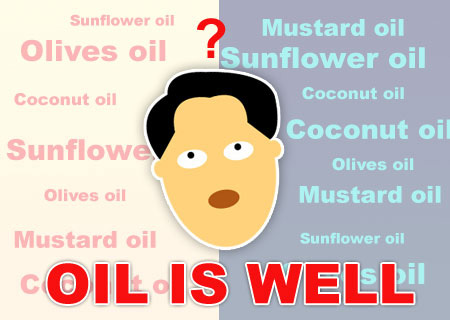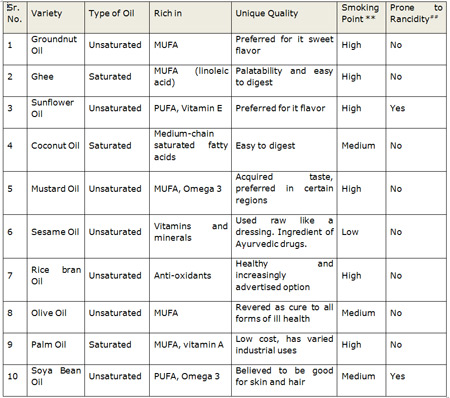Advertisements say a lot about a society’s culture and current mood. They are a reflection of cultural zeitgeist, so they change as society changes. I’m sure you are already thinking about your favorite advertisement from the yesteryear or maybe a recent one that has caught your attention. While you are in this mode, let me remind you of one such ad for cooking oil/ghee. The one I refer to is the one with the kid who is upset and is running away from home. A rather amicable looking grandfather comes up to him and asks him if he can postpone is getaway by a day. The reason, off course, being that jalebis have been prepared at home today. To this the boy exclaims – ‘Jalebi?’ Cut to present times and kids in such ads are either complaining about their father’s laziness or are worried about the health of the parent in question.
How then has an essential food item been villianised so rapidly that each drop makes you feel guiltier? Generally it is believed that oil is the cause of cholesterol and obesity. Misconceptions also claim that oil makes you fat, lethargic and paves way for life-threatening heart problems, so it is best to keep oil consumption minimal. But due to its palatability and satiety, oil also seems to be a vital part of our diet. Vitamins A, E, D and K which are fat soluble can be digested and accurately assimilated with the help of oil. Fats are often known as a store house of energy and are presumably broken down when body requires it. Apart from this, body fat also acts as a shock absorber and provides insulation from cold. Oil is not only involved in providing healthy eyes, skin, hair and nerves, but also maintains hormonal balance. Inclusion of oil is extremely helpful as it is an important constituent of all cells in the body.
What is all the fuss about?
Oils are calorically dense, i.e. packed with energy. Hence, a small quantity of fat releases a considerable amount of energy which, if not utilized, is stored as adipose tissue. The same fate awaits carbohydrates when consumed by a person who is prone to being stationary. Apart from a plethora of confusing ‘studies’ there are also these terms that hit the limelight in almost synchronized formats; then fade away. Many such spurts are marketing gimmicks. Such is the barrage of information that I myself get confused at times. So are we doomed to feel guilty with every crunch of potato chip? In one word; no. We intend to present to you everything you need to know about oil. After we are done, we hope to make you worry about oil only in a prescribed amount because oil is well.
Types of Oil:
Yes, I know you are already saying good cholesterol and bad cholesterol. If only life were as simple as an old Hindi movie. Fats are classified into saturated and unsaturated. Broadly, saturated fats are those that remain solid at room temperature like ghee. Unsaturated fats are those that are in liquid form at room temperature. Saturated refers to the amount hydrogen in the fat. Higher the level of hydrogen, more solid the oil. So saturated and unsaturated is a matter of degree and not absolutes. As a thumb rule, the more free-flowing the oil the better. Let us stick to better and not plain good and bad. Within unsaturated fats, there are monounsaturated and polyunsaturated fatty acids (MUFA and PUFA) which are essential nutrients. Polyunsaturated fats need to be stored carefully as exposure to heat/light leads to oxidation which makes it unhealthy. But finch not, as all will be made clear soon.
Partially hydrogenated or trans-fats: Vanaspati ghee falls in this category. Currently, these are the most derided form of fats because they increase cholesterol levels which predispose one to a number of health consequences for which the list can be claimed endless. Trans-fats do not offer a great deal in terms of flavor but are used mostly for economical reasons. Think of white sticky Halwas you may have consumed at weddings. Oils are hydrogenated to increase their shelf life but it also makes them less healthy. Many brands of vanaspati ghee masquerade as pure ghee which is why one needs to be alert and read labels carefully. A smarter way of saving money would be to simply use less oil. We use a little too much anyway.
What is Ghee?
Ghee is primarily used in India and its neighboring countries. It is prepared by heating butter. Hence, technically, it is clarified butter. Not processed, advertised butter that you are thinking of right now but the traditional one that froths from milk. It can be prepared from any kind of milk. In India, ghee prepared from buffalo milk is considered prestigious as buffalo milk has a higher fat content and is more expensive. It is saturated fat, hence feared. But it also contains vitamins and anti-oxidants, is easy to digest and adds great flavor. Recent studies have even hinted that ghee can actually help improve lipid profile. Everyone has heard an elderly person in the family singing praises of good old desi ghee. Because it is traditionally revered and perceived as expensive, it holds special place in the Indian kitchen. Elsewhere in the world, fats such as margarine are used.
Varieties of Oil:
Edible oils can be extracted from numerous sources, each having distinct character and advantages. Regional preferences dominate in choice of cooking oil. Most of us know only one type of oil that has been fed to us since childhood. Food cooked in a different variety of oil would taste very foreign. But in an increasingly urbanized and media saturated country, this need not be the case. Below is a list of commonly used oils and their profiles:
It should be noted that animal fat has high cholesterol content and low smoke point. This is true for most animal based products including milk and its byproducts. Unlike animal products, vegetable oils do not contain cholesterol itself but can promote its levels in the body when consumed in large quantities. You may find many of these varieties as being hard on the taste buds and/or your pocket. Many may not be available at your neighborhood store. But the idea here is to experiment, mix and match. As each kind of oil has its benefits and disadvantages; switching between varieties would help in maintaining favorable lipid profile.
Needless to say, this would require cooking yourself at home. There are numerous ways to make healthy food using minimum oil. Diet recipes can perhaps be taken up in another feature. The same kind of fried food had outside can be more unhealthy due to the quality of ingredients used and re-heating of oil. And you cannot have diet chips for lunch and dinner, can you?
Calorific calculations:
As we mentioned earlier, oil contains a large amount of energy. 1 gram of fat yields 9 calories of energy as against 4 calories from a gram of protein or carbohydrate. It is recommended that no more than 30% of daily calorific equipment be consumed in the form of fats. Out of this, only 1/3rd, i.e. 10% of total daily requirement should come from saturated fats. In case of people with high cholesterol levels and heart conditions, 20% or less calorie consumption from fat is recommended. So, at this point, you are wondering what software you will need to do this calculation. Per gram energy has already been mentioned and different brackets of daily calorie requirement are established based on age, sex and activity. Based on this, a very neat chart can be prepared showing how many calories and by extension, how many tea or tablespoons you may consume without worrying about your heart. But the internet has vast resources so we will let other websites deal with it.
A more workable option is to have a thumb rule – no more than 4 teaspoons (20 ml) of oil to be consumed in a day. Many people consume as much as 8 teaspoons a day. The truth is such calculations are idealistic. Even if you end up measuring everything you consume, numbers can only get you so far. A lot depends on metabolic rate, level of activity, other eating habits, stress, genetics etc. Hence, our suggestion is – consume oil for the right reasons. Be aware of health implications as mentioned in this feature but don’t be stressed about imminent heart problems. Do simple things like not re-using oil, using less of it; avoid eating outside. If you have to, order food that is not fried like baked dishes and salads.
-Punit Pania


